The Economics and Statistics Division maintains archives of previous publications for accountability purposes, but makes no updates to keep these documents current with the latest data revisions from Statistics Canada. As a result, information in older documents may not be accurate. Please exercise caution when referring to older documents. For the latest information and historical data, please contact the individual listed to the right.
<--- Return to Archive
For additional information relating to this article, please contact:
November 30, 2021COMPENSATION OF EMPLOYEES Q3 2021 With Q3 reference results, year-over-year (Q3 2021 vs Q3 2020) and year-to-date (Jan-Sep 2021 vs Jan-Sep 2021) are showing the rebounds in economic activity from the unprecedented declines observed at the start of the COVID-19 pandemic.
Nova Scotia’s seasonally adjusted employee compensation (wages and salaries + employers’ social contributions) increased 2.0% in the third quarter of 2021 to $6.647 billion. The wages and salaries portion of employee compensation increased 2.0% to $5.751 billion in the third quarter and employers' social contributions were up 1.5% to $896 million.
Employee compensation in the third quarter was up 8.3% in Nova Scotia when compared to the third quarter of 2020 with a 8.2% increase in wages and salaries and a 8.7% increase in employers' social contributions.

Compared to September 2020, employee compensation increased 8.1%, with wages and salaries up 8.1% and employers' social contributions up 8.2%.
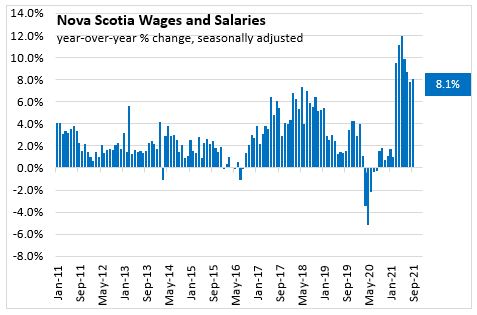
Provincial Comparison
In the third quarter of 2021, Canada’s employee compensation was up 2.9% from the previous quarter with all provinces except Prince Edward Island (-0.2%) registering gains. British Columbia (+3.7%) and Ontario (+3.2%) posted the largest increases in the third quarter.

For January-September 2021, Canada's employee compensation increased 9.1% compared to January-September 2020. All provinces had increases. The largest percentage increases were in Prince Edward Island(+11.9%) and British Columbia (+11.2%). The smallest increases were in Alberta (+5.8%) and Saskatchewan (+6.0%).
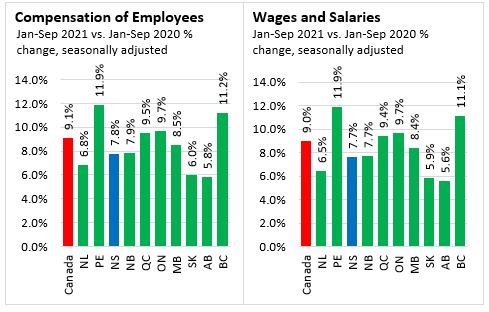
Nova Scotia's monthly employee compensation has been above pre-COVID February 2020 levels since October 2020. As of September 2021 employee compensation is 7.2% higher than February 2020, with wages and salaries up 7.2% and employers' social contributions up 7.0%.
Compared to February 2020, all provinces had higher compensation of employees in September 2021 with the largest increase in Prince Edward Island (+11.0%) and British Columbia (+10.1%). Alberta had the smallest growth since February 2020 at 1.7%.

Nova Scotia Sectors (unadjusted, Q3 2021 vs. Q3 2020)
Comparing the seasonally unadjusted data for Q3 2021 with the same quarter in 2020, total wages and salaries increased 8.1% in Nova Scotia.
Mining and oil and gas extraction (-16.8%) was the only sector that reported lower wages and salaries. Others sectors in the goods-producing industries reported double digit growth: agriculture, forestry, fishing (+26.4%), manufacturing (+10.4%), construction (+10.0%), and utilities (+10.8%).
Professional and personal services (+15.4%) and finance and insurance (+8.2%) reported higher growth than wholesale and retail trade (+4.1%), transportation and storage (+0.2%) and information and cultural industries (+0.5%).
Federal public administration (+11.8%) and military (+13.9%) wages and salaries were up in Q3 2021 compared to Q3 2020 and there were smaller increases in educational services (+4.9%) and health care and social assistance (+5.5%).
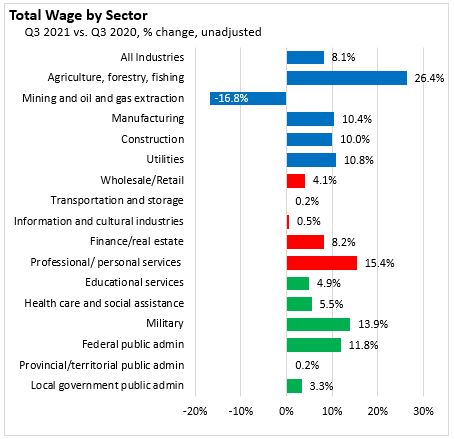

Nova Scotia Sectors (unadjusted, Jan-Sep 2021 vs. Jan-Sep 2020)
On a year-to-date basis, Nova Scotia's unadjusted total wages and salaries earned has increased 7.6%. Agriculture, forestry fishing (+31.5%), military (+21.3%), and federal public administration (15.4%) report the largest increases. Manufacturing, construction, finance and insurance, and professional and personal services have all grown at by at least 10%. There has been lower total wage and salaries in mining and oil and gas extraction (-14.4%), information and cultural industries (-2.0%), and local government public administration (-0.6%).
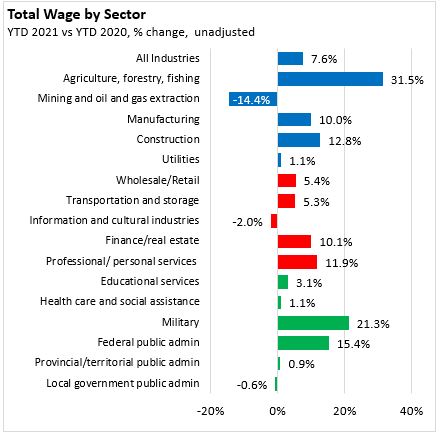
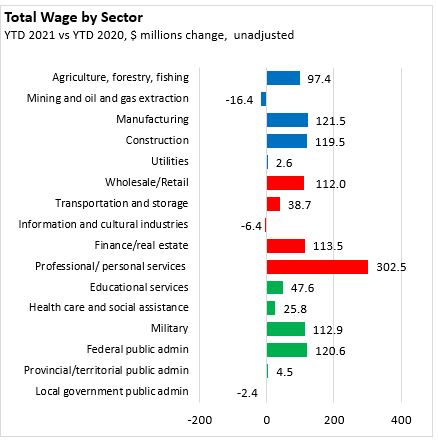
Note: comparison of wages and salaries by sector rely on data that are neither seasonally adjusted nor adjusted to reflect differences in pay periods from one year to the next. Compensation of employees data includes wage and salaries income that is supported by government subsidy programs including COVID-19 measures such as the Canadian Emergency Wage Subsidy.
Statistics Canada. Table 36-10-0205-01 Wages, salaries and employers' social contributions (x 1,000)
<--- Return to Archive